Introduction
The law in most countries requires public companies to publish audited financial statements. These statements are used by various groups in making decisions about their interaction with an entity. Published financial statements provide the potential users with a narrow insight into the financial strengths and weaknesses of a business.
Such a comprehensive view of a business is important as it would influence users’ decisions on whether to continue their association with the business. Ratio analysis is an important tool for analyzing the financial position of a company. The results of ratio analysis provide adequate information for evaluating the performance of a company.
Choice of company and justification for the choice
J Sainsbury PLC and Wm Morrison Supermarkets PLC, based in the United Kingdom, are public limited companies that trade on the London Stock Exchange. Both companies operate in the United Kingdom’s retail industry. J Sainsbury PLC takes about 17.7 percent of the market share in the UK supermarket. Besides, it is the second largest chain of supermarkets in the industry after Tesco. The company has about 1,106 stores.
The company employs about 152,000 employees in their stores (J Sainsbury PLC 2014a). On the other hand, Wm Morrison Supermarkets PLC ranks fourth among the top five supermarkets in the UK retail industry with a market share of 11.3%. The company has presence in over 600 locations.
The company engages about 132,000 employees (Wm Morrison Supermarkets PLC 2014a). Retail industry in the United Kingdom is quite competitive and the top players engage in aggressive competition so as to increase their market share. The table presented below shows the recent statistics of market share of the United Kingdom’s retail industry.
The information on the market share can be presented in a pie chart as shown below.
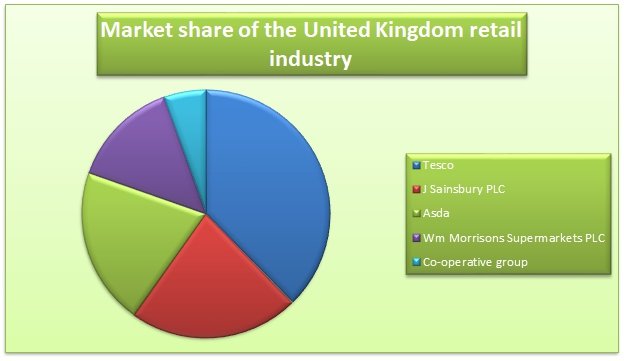
The two companies are a suitable choice for analysis because they are among the top five in the UK retail industry. Besides, the companies have operated in the retail industry since 1800s. This implies that they have experienced and survived the swings in the economy over a long period of time. The paper seeks to carry out a comparative financial analysis of Sainsbury and Morrison Supermarkets for a period of five years, that is, between 2008 and 2012.
Critical analysis of the ratios
Profitability ratios
Source of data – Morningstar, Inc. 2014b; Morningstar, Inc. 2014a; J Sainsbury PLC 2014b; Wm Morrison Supermarkets PLC 2014b
The net profit margin of Sainsbury increased by a small percentage during the five years. The net profit margin increased between 2008 and 2010. However, in 2011 and 2012, the company reported a decline in the value of the ratio. The same trend was observed in the values of return on assets and return on equity.
In the case of Morrisons, The profitability ratios increased between 2008 and 2011. In 2012, the company reported a decline in the value of profitability ratios. Further, it can be noted that the profitability ratios for Morrisons are higher than those of Sainsbury. This implies that Morrison Supermarket is more efficient in managing pricing and the cost of operations.
It also implies that the Morrison Supermarket is more efficient in using assets and shareholders’ fund to generate sales and net profit than Sainsbury (Atrill 2009). Further, both companies reported a decline in profitability in 2012. This may indicate that there was a decline in profitability within the industry. The graph presented below shows the trend of profitability ratio for the two companies.
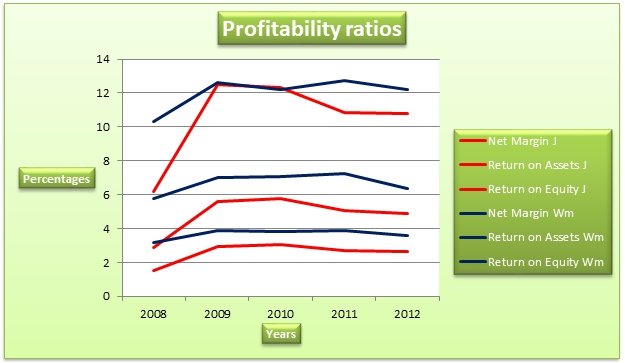
In the graph above and subsequent graphs, ‘J’ represents line graphs for J Sainsbury PLC while ‘Wm’ represented line graphs for Wm Morrison Supermarkets PLC.
Liquidity ratios
The liquidity ratios for Sainsbury fluctuated during the five year period. The current and quick ratio for the company increased between 2008 and 2009. However, in 2010, the company reported a decline in the liquidity ratios. The values improved in 2011 and later declined in 2012. In the case of Morrison Supermarket, the current and quick ratio declined in 2009, the values later improved in the subsequent years.
The liquidity ratios for Sainsbury PLC are higher than those of Morrison Supermarket. This implies that Sainsbury is more efficient in paying current debt than Morrison Supermarket. The information in the table also reveals that the current and quick ratios for both companies are less than one.
This implies that the current asset of both companies cannot adequately pay the current liabilities (Brigham & Houston 2007; Brigham & Ehrhardt 2009). This can be attributed to the industry in which the companies operate. Companies operating in retail industry often have low liquidity ratios due to the nature of their businesses. The graph presented shows the liquidity ratios for the two companies.
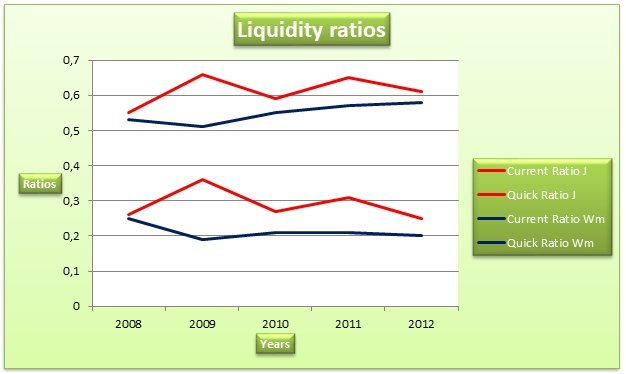
Gearing ratios
The gearing ratios focus on the amount of debt in the capital structure of a company. A high value of gearing ratio implies that a company has a high amount of debt in the capital structure. The financial leverage for Sainsbury ranged between 2.1 and 2.29 during the five year period while the value of debt to equity ratio ranged between 0.43 and 0.50.
It can be observed that there was a general decline in the value of the gearing ratio. In the case of Morrison Supermarket, the financial leverage ranged between 1.69 and 2.01. It can also be observed that the company experienced an increase in the financial leverage over the years. Debt to equity ratio for the company ranged between 0.19 and 0.46. The two companies reported a decline in the value of gearing ratios between 2008 and 2010.
However, in 2011 and 2012, the value of the ratios increased. The trend can be attributed to the economic meltdown that was reported in late 2008. The companies required external funding to finance operations (Brigham & Houston 2007; Brigham & Ehrhardt 2009).
It can also be pointed out that the gearing ratios for Sainsbury are higher than those of Morrison Supermarket. This explains the low profitability of the company. It also increases the risk of the shareholders’ fund (Collier 2009). The graph presented below show the trend of the gearing ratios.
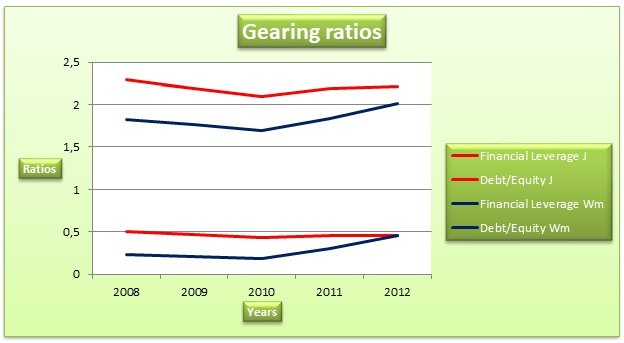
Investment ratios
The investment ratios are used as a measure of valuation of shares of a company. The ratios compare the price of shares and various attributes such as earnings, book value of assets, cash flow and sales (Haber 2004). The investment ratios for Sainsbury declined between 2008 and 2010.
There was a decline in the value of the ratios between 2011 and 2012. In the case of Morrison Supermarkets, the value of the investment ratios increased between 2009 and 2010. There was a decline in the value of the ratios in 2011. In the table, it can be noted that the investment ratios for the two companies are relatively equal.
Therefore, an investor may be indifferent about which company to invest in based on the investment ratios. The price/earnings ratio measures the market value per share in relation to its earnings while price to book ratio measures the stock price of shares of a company in relation to book value of the assets (Holmes, Sugden & Gee 2005). The graph presented below shows the trend of investment ratios over the five years.
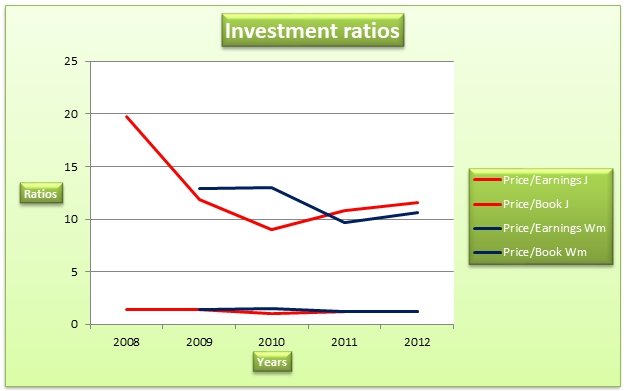
Weaknesses of ratios
There are a number of weaknesses of ratios. Therefore, it is necessary to take into account some of these weaknesses when using ratios as the main tool for comparing the financial performance of two companies. First, it is difficult to use a set of industry average ratios when analyzing large companies that have different business segment which fall in different industries. This creates a major challenge when using industry average ratios to compare performance of such companies.
The second weakness is that inflation distorts the financial statements of companies. Thus, using ratios to analyze the performance of a company or a group of companies in different regions may be a challenge (McLaney & Atrill 2008). In such cases, an analyst may need to use personal judgement to evaluate the performance of a business.
The third weakness of ratios is that it is highly distorted by seasonal factors. It is quite difficult to incorporate the impact of seasonal factors when analyzing the financial performance of a business using ratios.
For instance a company may report a sporadic increase in sales of a certain product during a one season such as winter. This will distort the ratios calculated. Therefore, an analyst may be required to have prior knowledge of the seasonal factors that affects a business before using ratios to analyze the financial performance of such a business (Siddiqui 2005).
The fourth weakness of ratio analysis is that the use of different accounting practices hinders the ability to use ratios to analyze the performance of a company using ratios. For instance, when carrying out inventory valuation one company may decide to use FIFO while another company may use weighted average. This may make it difficult to use ratios to compare the two companies. The fifth weakness is that different ratios under the same category may give differing positions on the performance of a company.
Thus, it may be difficult to give a generalized view of the performance of a company. For instance, under profitability ratios, net profit margin may indicate that the profitability of a company is declining over time while return on assets may indicate that the profitability of a company is increasing over time.
This makes it difficult to give a conclusive decision on the performance of a company. Finally, some ratios may be difficult to interpret some ratios as to whether they are good or bad. For instance, high liquidity ratios may be interpreted as good or bad (Vance 2003).
Conclusion and recommendation
The paper carried out a comparative financial analysis of J Sainsbury PLC and Wm Morrison Supermarkets PLC for a period of five years, that is, between 2008 and 2012. Analysis of market share indicates that Sainsbury has a larger market share than Morrison Supermarkets in the UK retail industry.
Further, analysis of profitability indicates that Morrison Supermarket is more profitable than Sainsbury. Based on liquidity, it can be noted that Sainsbury has a better liquidity position than Morrison. Further, the gearing level of Morrison Supermarkets is lower than that of Sainsbury. Finally, the investment ratios for the two companies are fairly equal. Thus, analysis of the two companies shows that they have a fairly equal financial standing.
In terms of market share and liquidity, Sainsbury is superior to Morrison Supermarket. However, in terms of profitability and gearing, it can be pointed out that Morrison Supermarket is superior to Sainsbury. An investor is likely to base his decision on profitability, gearing level and investment ratios.
Thus, Morrison Supermarket will be the most suitable company to invest in. The paper also discussed the various shortcomings of use of ratio analysis. Even though it is a suitable for comparing the financial performance of various companies, a lot of personal judgment is required when using the tool.
References
Atrill, P. 2009, Financial management for decision makers, Prentice Hall, USA.
Brigham, E. & Ehrhardt, M. 2009, Financial management theory and practice, Cengage Learning, USA.
Brigham, E. & Houston, J. 2007, Fundamentals of financial management, Cengage Learning, USA.
Collier, P. 2009, Accounting for managers, John Wiley & Sons Ltd, USA.
Haber, R. 2004, Accounting demystified, American Management Association, New York.
Holmes, G., Sugden, A. & Gee, P. 2005, Interpreting company reports, Prentice Hall, USA.
J. Sainsbury PLC 2014a, About us. Web.
J. Sainsbury PLC 2014b, Annual report and financial statements 2013. Web.
McLaney, E. & Atrill, P. 2008, Financial accounting for decision makers, Prentice Hall, USA.
Morningstar, Inc. 2014a, Sainsbury (J) PLC. Web.
Morningstar, Inc. 2014b, Wm Morrison Supermarkets PLC. Web.
Siddiqui, A. 2005, Managerial economics and financial analysis, New Age International (P) Limited, New Delhi.
Vance, D. 2003, Financial analysis and decision making: Tools and techniques to solve, McGraw-Hill books, United States.
Wm Morrison Supermarkets PLC 2014a, About us. Web.
Wm Morrison Supermarkets PLC 2014b, Financial reports. Web.